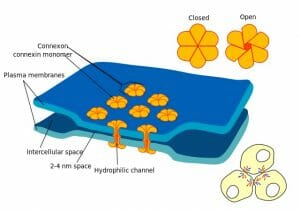Gap Junction Definition
Gap junctions are a type of cell junction in which adjacent cells are connected through protein channels. These channels connect the cytoplasm of each cell and allow molecules, ions, and electrical signals to pass between them. Gap junctions are found in between the vast majority of cells within the body because they are found between all cells that are directly touching other cells. Exceptions include cells that move around and do not usually come into close contact with other cells, such as sperm cells and red blood cells. Gap junctions are only found in animal cells; plant cells are connected by channels called plasmodesmata instead.
Function of Gap Junctions
The main function of gap junctions is to connect cells together so that molecules may pass from one cell to the other. This allows for cell-to-cell communication, and makes it so that molecules can directly enter neighboring cells without having to go through the extracellular fluid surrounding the cells. Gap junctions are especially important during embryonic development, a time when neighboring cells must communicate with each other in order for them to develop in the right place at the right time. If gap junctions are blocked, embryos cannot develop normally.
Gap junctions make cells chemically or electrically coupled. This means that the cells are linked together and can transfer molecules to each other for use in reactions. Electrical coupling occurs in the heart, where cells receive the signal to contract the heart muscle at the same time through gap junctions. It also occurs in neurons, which can be connected to each other by electrical synapses in addition to the well-known chemical synapses that neurotransmitters are released from.
When a cell starts to die from disease or injury, it sends out signals through its gap junctions. These signals can cause nearby cells to die even if they are not diseased or injured. This is called the “bystander effect”, since the nearby cells are innocent bystanders that become victims. However, sometimes groups of adjacent cells need to die during development, so gap junctions facilitate this process. In addition, cells can also send therapeutic compounds to each other through gap junctions, and gap junctions are being researched as a method of therapeutic drug delivery.
Gap Junction Structure
In vertebrate cells, gap junctions are made up of connexin proteins. (The cells of invertebrates have gap junctions that are composed of innexin proteins, which are not related to connexin proteins but perform a similar function.) Groups of six connexins form a connexon, and two connexons are put together to form a channel that molecules can pass through. Other channels in gap junctions are made up of pannexin proteins. Relatively less is known about pannexins; they were originally thought only to form channels within a cell, not between cells. Hundreds of channels are found together at the site of a gap junction in what is known as a gap junction plaque. A plaque is a mass of proteins.

This figure depicts channels at a gap junction.
Other Cell Junctions
The two other types of cell junctions in vertebrates are anchoring junctions and tight junctions. Anchoring junctions adhere cells through proteins that are connected to the cell’s cytoskeleton. Tight junctions are areas where cells are bound very closely together to form a barrier, and they are often found in epithelial cells, which are cells found on the surface of the body and lining organs.
Plant cells do not have gap junctions, but they do have plasmodesmata, which are channels that connect the cytoplasm of two adjacent plant cells. Plasmodesmata are structured differently than gap junctions due to plant cells having thick cell walls, their function is essentially the same. Plant cells can regulate the passage of small molecules and communicate with each other through their plasmodesmata.
Related Biology Terms
- Anchoring junction – A type of cell junction in which cells are connected by a mass of proteins.
- Tight junction – A type of cell junction where cells are tightly bonded to form a barrier.
- Plasmodesmata – Channels that connect the cytoplasm of adjacent plant cells.
- Connexin – A family of proteins that makes up gap junctions.
Quiz
1. How many connexins are found in one gap junction channel?
A. 6
B. 4
C. 12
D. 2
2. What is the “bystander effect” in relation to gap junctions?
A. Molecules can enter neighboring cells without passing through extracellular fluid.
B. Cells next to a cell that is undergoing cell death can also die.
C. Cells can transmit therapeutic compounds to one another.
D. Gap junctions are only found in cells that are located next to other cells.
3. Which is NOT a function of gap junctions?
A. Forming a barrier
B. Allowing molecules to pass between cells
C. Electrically coupling cells
D. Ensuring correct embryonic development
References
- Alberts, Bruce, et al. (1994). Molecular Biology of the Cell, 3rd. ed. Ch. 1. Garland Science: New York. ISBN: 978-0815316206.
- Davidson, Michael W. (2015-11-13). “Plasmodesmata”. Molecular Expressions Cell Biology. Retrieved 2017-04-13 from https://micro.magnet.fsu.edu/.
- Evans, W.H. and Martin, P.E. (2002). “Gap junctions: structure and function (Review)”. Mol. Membr. Biol. 19 (2): 121–36.
- Kimball, John W. (2015-03-02). “Junctions Between Cells”. Kimball’s Biology Pages. Retrieved 2017-04-12 from http://www.biology-pages.info/.
- Russell, Peter. J., and Hertz, Paul E. (2011). Biology: The Dynamic Science, 2nd ed. Ch. 5. Brooks/Cole: Boston. ISBN: 978-0538494182.
- Wei, C.J., Xu, X., and Lo, C.W. (2004). “Connexins and cell signaling in development and disease”. Annu. Rev. Cell Dev. Biol. 20: 811–38.
